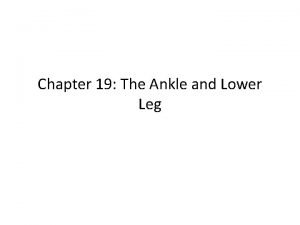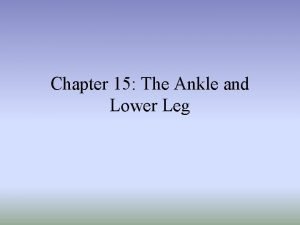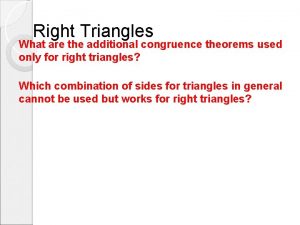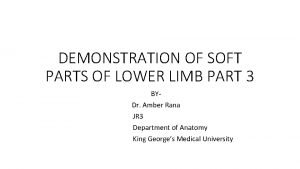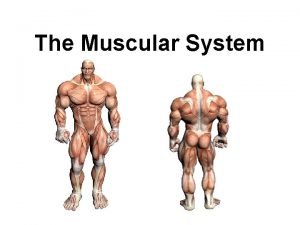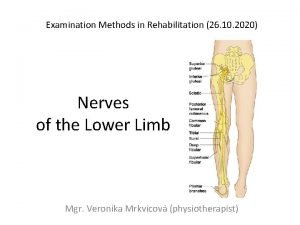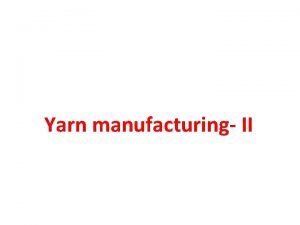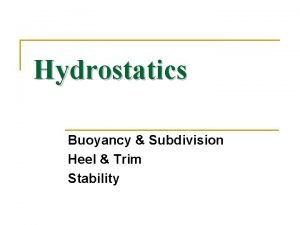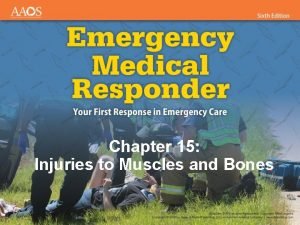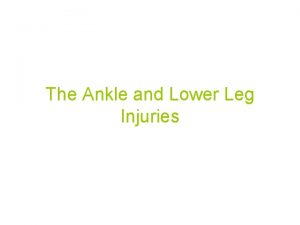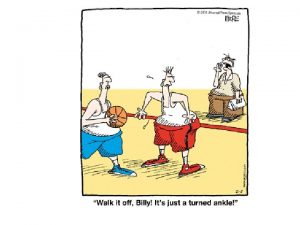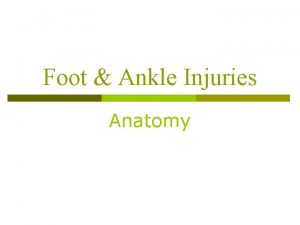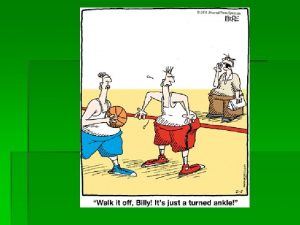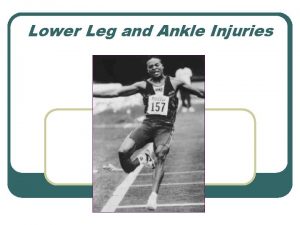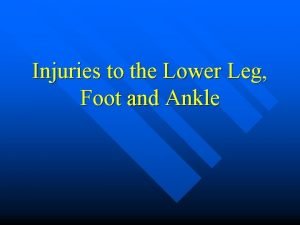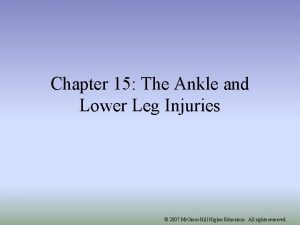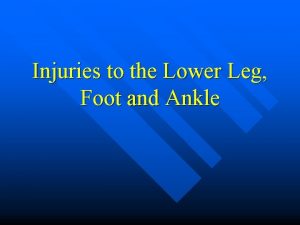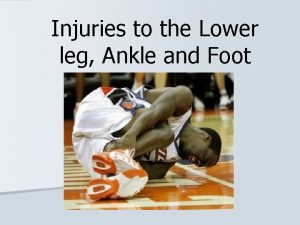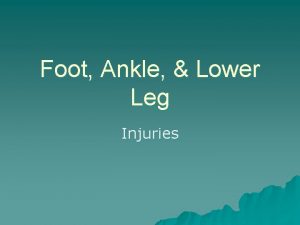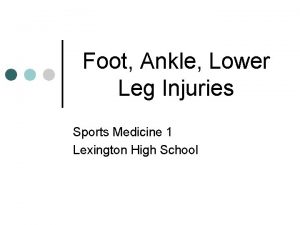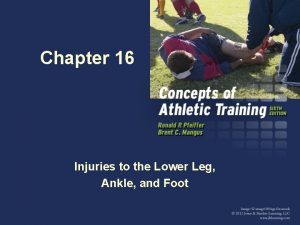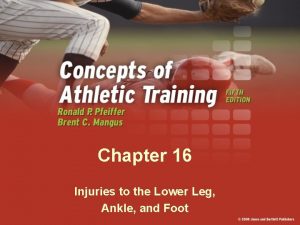The Ankle and Lower Leg Injuries Prevention Heel


















- Slides: 18

The Ankle and Lower Leg Injuries

• Prevention: – Heel cord stretching • Before and after activity – Strength training • Achieving static & dynamic joint stability – Neuromuscular control • Enhanced by locomotion on uneven surfaces or balance board – Footwear • Shoes for which they are intended – Taping vs. bracing • Prophylactic protection

• Functional Exam – If the following movements aggravate a recent injury, they should be avoided • • Walks on toes (tests PF) Walks on heels (tests DF) Walks on lateral border of feet (inversion) Walks on medial border of feet (eversion) Hops on injured ankle Start/stop run motion Changing directions quickly Figure 8’s

Ankle Sprains

• Ankle Sprains Inversion or lateral ankle sprain

Cause: inversion with plantar flexion S&S: swelling; pt. tenderness; discoloration; joint Instability; sprain grades 1, 2, 3 Care: RICE; ice first 72 hrs (20 min on, 1 hr off); ace wrap (begin distal to proximal) NSAIDs; horseshoe; splint; crutches; rehab focusing on balancing

• Eversion ankle sprains – Represent only about 510% of all ankle sprains – Less common due to bony and ligamentous anatomy – Takes longer to heal due to the strength of the deltoid ligaments

S&S: medial pain; unable to weight bear; grades 1, 2, 3 Care: xray to rule out fracture; RICE; NSAIDs; rehab; same as lateral ankle

• Ankle fractures Cause: same mechanism as sprain S&S: immediate swelling; pt. tenderness over bone; apprehension to wt. bear Care: splint; referral for xray; immobilization 6 -8 wks

• Tibial and Fibular fx Cause: tibia = most common; indirect or direct trauma; S&S: immediate pain; swelling; deformity Care: referral; immobilization for wks - mo.

• Tibial and fibular stress fracture Cause: tibia>fibula; repetitive loading; biomechanical foot problems; training errors; nutritional deficiencies S&S: pain with activity; worse when stopped; focal pt. tenderness; swelling Care: REST; walking boot

• Medial Tibial Stress Syndrome (MTSS) Cause: repetitive microtrauma; muscle weakness; shoes; changing surfaces; malalignment; heel cord tightness S&S: diffuse pain; initial pain = after activity; as condition progresses = constant Care: r/o stress fracture; G/S stretching; ice; strengthening; correct foot mechanics; taping

• Compartment Syndrome Cause: acute or chronic; increase in pressure causes compression of muscle and neurovascular structures S&S: deep aching pain; tightness/swelling of compartment; neurological involvement is rare; weakness in foot and toe extension Care: rest; ice; NSAIDs; surgery (return usually in 10 days)

• Achilles Tendon Rupture Cause: sudden, forceful plantar flexion; usually occurs in 30+ y. o. S&S: feels snap/pop; reports feeling “kicked in calf”; plantar flexion = painful and limited; palpable defect Care: surgery; 6 -8 wks immobilization

• Achilles tendinitis Cause: repetitive stress/strains; in duration/intensity is too soon; hill workouts pain S&S: pain; stiffness; gradual onset; warm and painful to palpation; thickening; crepitus Care: activity; gastroc/soleus stretch; shoes; transverse friction massage; taping

• Shin Contusions Cause: forceful blow to anterior leg S&S: intense pain; hematoma forms; possible compartment syndrome or fracture Care: RICE; NSAIDs; padding; massage once swelling has subsided

• Leg cramps and spasms – Once an athlete receives a cramp they are likely to keep recurring during activity – In some cases it is best to stop activity to prevent further injury Cause: fatigue; dehydration; electrolyte imbalance S&S: pain with contraction of the calf muscle Care: mild, gradual stretching; ice massage; water/electrolyte replacement

• Gastrocnemius strain Cause: stop and go; jumping; medial head most susceptible S&S: pain; swelling; muscle disability; Care: RICE; NSAIDs; gentle stretching; heel wedge; elastic wrap
 Chapter 19 worksheet the ankle and lower leg
Chapter 19 worksheet the ankle and lower leg Chapter 15 worksheet the ankle and lower leg
Chapter 15 worksheet the ankle and lower leg Primary prevention secondary prevention tertiary prevention
Primary prevention secondary prevention tertiary prevention Basic dance steps in heel and toe polka
Basic dance steps in heel and toe polka Saa congruence theorem
Saa congruence theorem Great saphenous
Great saphenous Parts of lower leg
Parts of lower leg Tibial pulse location
Tibial pulse location Temporalis
Temporalis Extensors of the leg
Extensors of the leg Lymphatic system in the neck
Lymphatic system in the neck Obturator
Obturator Objective of draw frame
Objective of draw frame Trim and heel
Trim and heel Unit 15:1 providing first aid
Unit 15:1 providing first aid A short backboard or vest-style immobilization
A short backboard or vest-style immobilization Chapter 21 caring for head and spine injuries
Chapter 21 caring for head and spine injuries Injuries to muscles and bones chapter 15
Injuries to muscles and bones chapter 15 Chapter 14 promotion of safety
Chapter 14 promotion of safety
